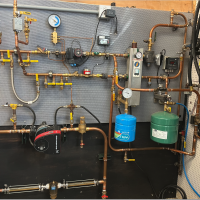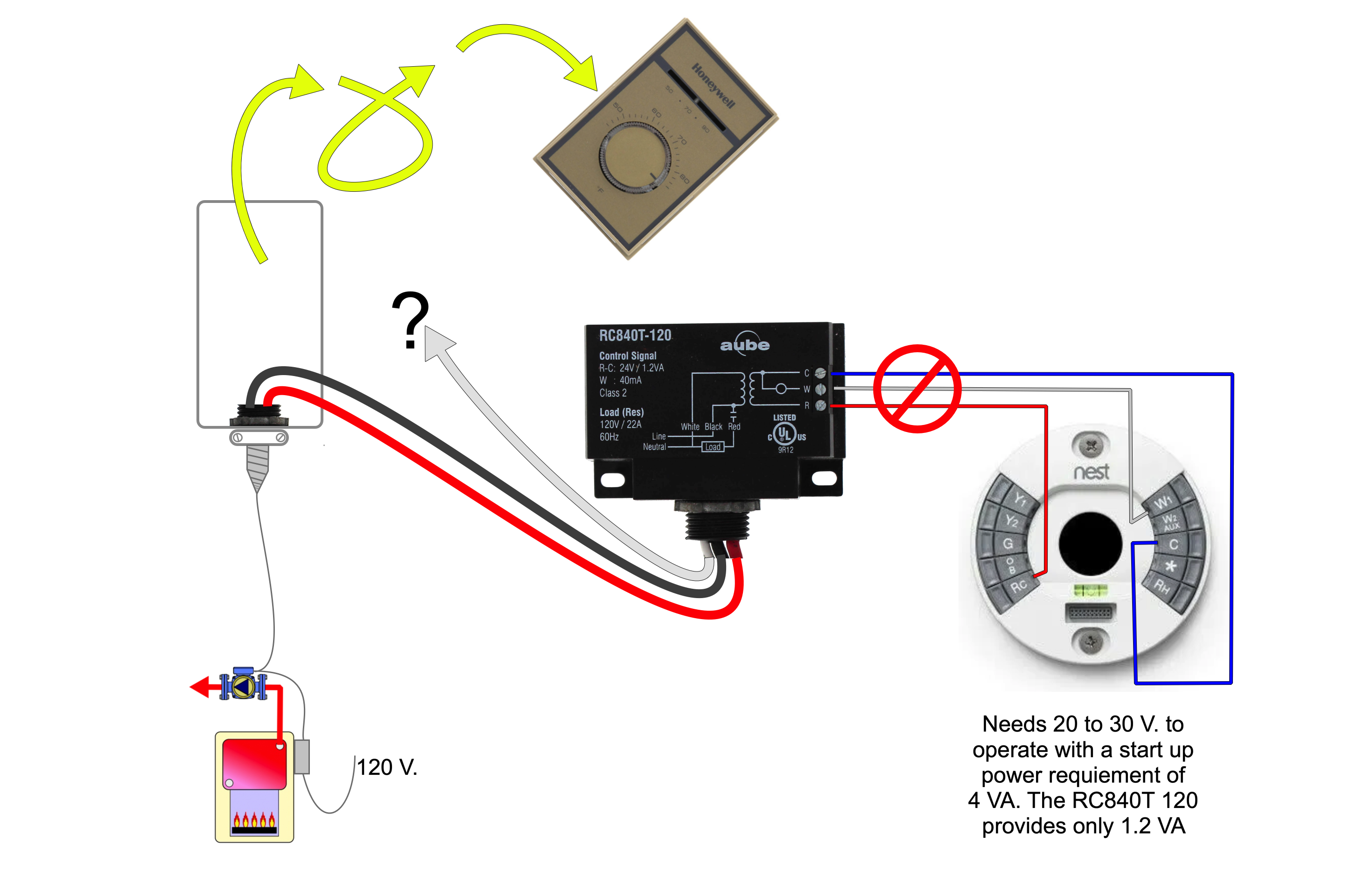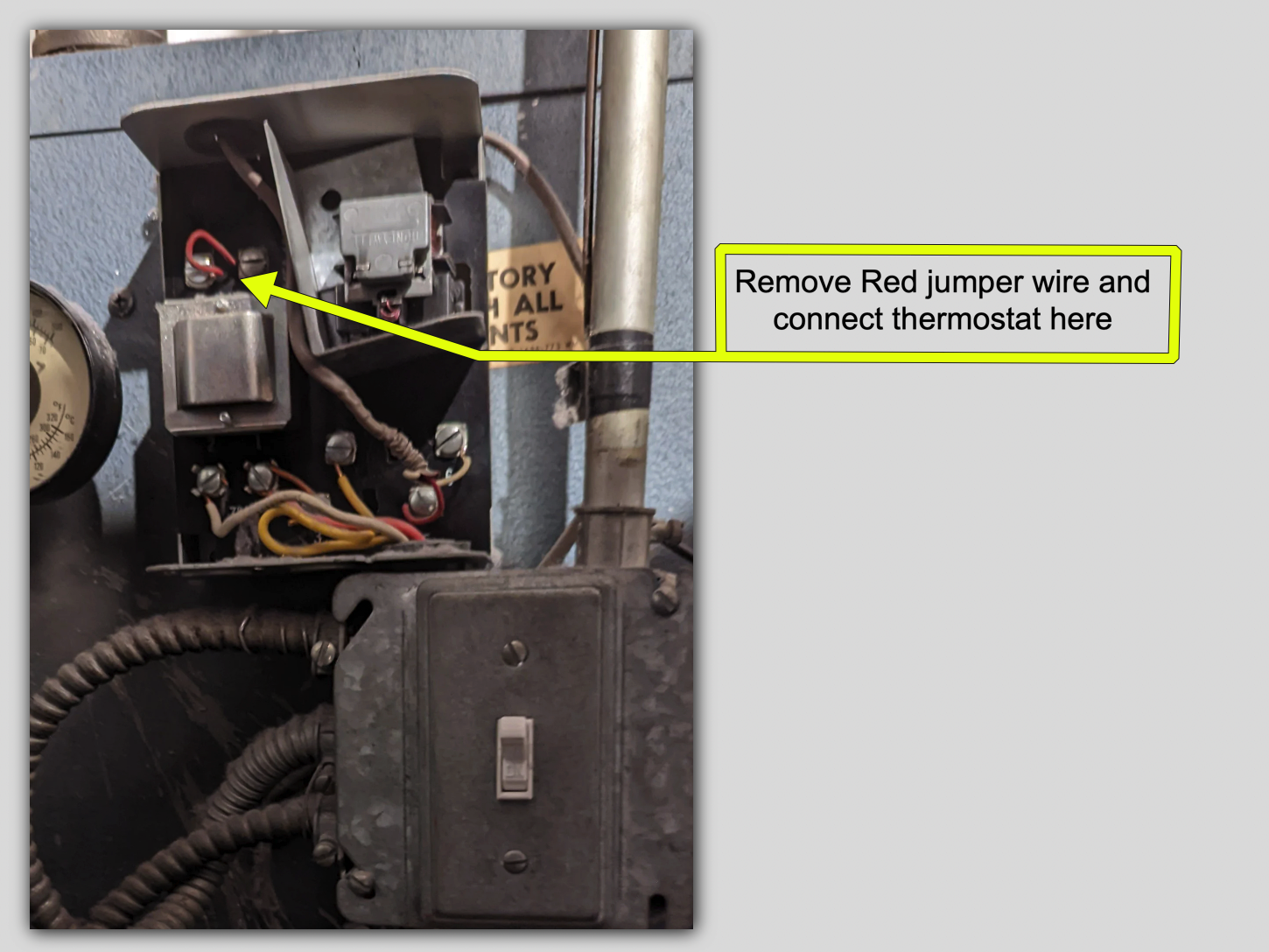Line voltage at thermostat
I'm in NY in a house that was built in 1954. I've been in this house for almost 30 years and I have never updated any part of the heating system which is gas, hot water, radiators. I have 2 zones, the basement and the rest of the house. The basement has a regular low voltage 24v line thermostat. The upstairs thermostat is 120v. This limits me with the type of thermostat I can use there. Can anyone explain why this thermostat is line voltage? Every place I look for an answer, it says line voltage is used in electric baseboard heating. I have no electric baseboard heating, only regular hot water radiators. I really want to install a smart thermostat but can't figure out how do do this. Can someone please give me some guidance? Thanks in advance for any assistance.
Comments
-
It depends on the controls located at the heater. Can you look at the heater and take some photos of the controls from far enough back so we can see how they might be connected. The brand name and model number of the heater or the wiring diagram that is connected to h the heater may also help
Edward Young Retired
After you make that expensive repair and you still have the same problem, What will you check next?
0 -
We would need to know a lot more about your system and the wiring, and why it's a line voltage thermostat.
Any semi-competent tech should be able to help you out.
Taking a WAG, remove all the line voltage thermostat wiring back to wherever it came from. Run new lv wiring, hook up your not-so-smart thermostat. Down at the basement, use a RIB relay to have the lv thermostat control the line voltage existing wiring. You may not even need to do all that if you can control your system with low voltage wiring/controls.
Again, just a WAG as I have no idea what you have or why it's wired the way it is.0 -
does the system use unit ventilators or fancoils or something like that and the t-stat is controlling the blower?
0 -
or maybe it just controls a circulator for that zone.
0 -
-
It might even be a line voltage thermostat being used on a 24 VAC circuit. but it is keeping the Nest away @pecmsg
Edward Young Retired
After you make that expensive repair and you still have the same problem, What will you check next?
0 -
-
It was cheaper and easier to run was the reason :)
Best to run new 18 wire to the boiler
There was an error rendering this rich post.
0 -
Thanks for all the suggestions. It's definitely line voltage as I have already replaced the original thermostat with a Lux model that I had to search for to find a line voltage one. They don't make many types for line voltage. I didn't have a c wire at my basement low V thermostat so I just ran a 24v transformer into it and it seems to be working fine. Not sure what pics are good but I'm attaching a few. I bought these 2 nests a couple of years ago with the intention of figuring a work around for the c wire and finally did the basement yesterday. For the Line voltage one I bought an Aube RC840T-120 thinking I could just put the line voltage in and wire the low voltage out to the nest but I don't want to blow up my system. Attaching photos of the relays now. And thanks again. I'm just a DIY guy trying to find a cheap way of getting it done and like most people, nothing's easy for me.
0 -
There are some nice line voltage thermostats available from the companies that do electric radiant systems. Here are some Sun Touch
Bob "hot rod" Rohr
trainer for Caleffi NA
Living the hydronic dream0 -
What kind of wire runs in to the thermostat? Looking at the controls it looks like it at least started out as low energy. Not really clear why t-t is jumpered on one of the relays.
0 -
-
Can I use a thermostat that is meant for an electric heating system, or is a thermostat a thermostat and any line voltage one would work for me?
0 -
you have to make sure it can be set to a cycles per hour that matches your type of system, typically most types of electric systems want shorter cycles that you would want for cast iron radiators. If it is not a purely mechanical thermostat, if it needs to get power from the controlled circuit, it probably needs to be capable of using 120v vs the 240v or 208 v more common with electric resistance heating.
0 -
You would be better off with a low voltage stat. While newer line voltage stats may be ok, they are expensive and line voltage usually doesn't have as good sensitivity as low voltage.
Get some paper and a pencil and make a wiring diagram of your system and post it here and we can help you fix it up.
0 -
Thanks I'll do my best. Hopefully I'll post it tomorrow. Thanks again you guys are awesome. My other issue is I'm in a split level ranch and there's no easy way to get a new wire from the upstairs thermostat to the furnace. I used to install alarms and I've run all sorts of wires on my house so I know at least how to run wires. It can be done but it ain't gonna be easy.
0 -
To me finding a line voltage thermostat and replacing it with another proves nothing. Was the voltage ever actually measured ??? If in fact there is a 120 VAC circuit going to the thermostat a relay and transformer could be added so a 24 VAC thermostat could be used. Assuming the 120 VAC thermostat wires are dedicated exclusively for the thermostat purpose.
As @mattmia2 stated the Red jumper on the upper aquastat seems odd. Which aquastat is for which zone ?
National - U.S. Gas Boiler 45+ Years Old
Steam 300 SQ. FT. - EDR 347
One Pipe System0 -
-
-
-
Line volt controls was the builders special. No relays. Cheap dual aquastat.
0 -
He will need a third wire for power stealing thermostats.
8.33 lbs./gal. x 60 min./hr. x 20°ΔT = 10,000 BTU's/hour
Two btu per sq ft for degree difference for a slab0 -
it is a little tricky wiring romex to a low voltage t-stat
hopefully there is a box to make a wire conversion to stat wire
Bob "hot rod" Rohr
trainer for Caleffi NA
Living the hydronic dream0 -
LIKE THIS?
Edward Young Retired
After you make that expensive repair and you still have the same problem, What will you check next?
0 -
Romex has a third wire. sometimes it is bare other times it is green. You will want to use that as the C wire on the transformer just in case it is connected to a ground somewhere else in the home.
Edward Young Retired
After you make that expensive repair and you still have the same problem, What will you check next?
0 -
Does anyone know anything about this Aube RC840T-120 relay I got? Like I said, my original plan was to put the line voltage into this relay at the thermostat, then wire the thermostat from the relay. I was gonna attach the relay to a junction box in the wall. It looks like it's get the c wire from the relay too. I'm not sure if that's how it would work, I assume some kind of wizardry happens inside the relay that creates the c wire out to power the Nest. I didn't do this because I don't know if doing this would fry some part of my heating system.
0 -
My house is pretty old. Most of the BX doesn't have a ground so I have to use the metal casing as a ground when I can. Not even sure if that's a thing but I do it.
0 -
Not modern code, but acceptable in undisturbed old work. PROVIDED you can verify that the sheath is connected through to the switchgear as a ground. In quality old work, it will be, but check anyway. The risk is that some modifications have been made and the ground path has been interrupted by newer work.
Br. Jamie, osb
Building superintendent/caretaker, 7200 sq. ft. historic house museum with dependencies in New England1 -
-
I have done this in the past but stopped when I found out that the coiled metal casing can become corroded, that corrosion can act as insulation between the edges of the coiled exterior metal casing. If that happen under the right conditions the outer casing becomes a very long coil type resistance heater. I guess it happened to someone somewhere so I was told. So for the last 30+ years of my career, if the older BX wire did not have that additional uninsulated ground inside it, (or the green ground wire on the newer MC cable) I would not use the casing as the ground. But that's just me… and I was able to sell more replacement wire that way.
Edward Young Retired
After you make that expensive repair and you still have the same problem, What will you check next?
1 -
Regarding that RC840T-120 relay, you need to add a 24 VAC transformer to operate it with the Nest thermostat.
Edward Young Retired
After you make that expensive repair and you still have the same problem, What will you check next?
0 -
It's not "creating" the c wire power from the line voltage itself? It looks like it's tapped off on the output. I was obviously looking for the easy way out and saw what I wanted to see when I bought this. Guess I was wrong.
0 -
That relay looks like it would work. And it would but I doubt the transformer inside it has enough power to charge a Nest. It would be the perfect application if it was. Maybe someday they will make a Nest version
Everyone knows or should know that you are not supposed to use the bare or green in Romex or the cable armor of BX to carry the "C" wire current or anything else.
0 -
Yeah I was wondering why the 24v transformer I connected to my basement nest is the size of my fist and why this relay is so much smaller. Like I said I thought there was some kind of magic happening inside it. If I connect it and am getting 24v from both the c and the r, and the w and the r, then that should work though, right? I think the nest just needs the 24v to work. Or are you saying it wouldn't consistently provide needed power?
0 -
-
-
that control device only can supply 1.2 va so it couldn't power a thermostat and you would need hot, neutral, and load in that box to use it.
0 -
Ugh. Too good to be true. Thanks.
0 -
Ok so I just googled to understand what you're talking about and now I get it. Says smart thermostats that use Wi-Fi typically need at least 2va and sometimes 4va. But says the 1.2va is good to work a regular low voltage thermostat. So if I do connect this relay, I could at least have more options available to me as far as getting a better non smart but still programmable low voltage thermostat. Thanks for pointing this out.
0 -
Not a big enough transformer in that little black box, and where do you get Neutral for 120VAC?
I just looked at your 2 different circulator relays. they look like R845A relays that are using the 5 and 6 contact terminals to operate the burner circuit. I don't see any limit or aquastat controls in those photos. Can you post a picture of the other end of the wire from the 5 and 6 on the R845A controls?
As far as using a 24 VAC thermostat for your main floor zone, this is where you would connect the thermostat. Remove this Red jumper wire and place the two wires from your thermostat on T T terminals. Then it will be wired just like the basement zone.
The line voltage to terminal 1 on this R845A may need to be connected directly to power. the original wiring may go thru the thermostat before attaching to the 1 terminal. You will need to verify this.
Edward Young Retired
After you make that expensive repair and you still have the same problem, What will you check next?
0
Categories
- All Categories
- 87.3K THE MAIN WALL
- 3.2K A-C, Heat Pumps & Refrigeration
- 61 Biomass
- 427 Carbon Monoxide Awareness
- 119 Chimneys & Flues
- 2.1K Domestic Hot Water
- 5.8K Gas Heating
- 115 Geothermal
- 165 Indoor-Air Quality
- 3.7K Oil Heating
- 76 Pipe Deterioration
- 1K Plumbing
- 6.5K Radiant Heating
- 395 Solar
- 15.6K Strictly Steam
- 3.4K Thermostats and Controls
- 56 Water Quality
- 51 Industry Classes
- 50 Job Opportunities
- 18 Recall Announcements












